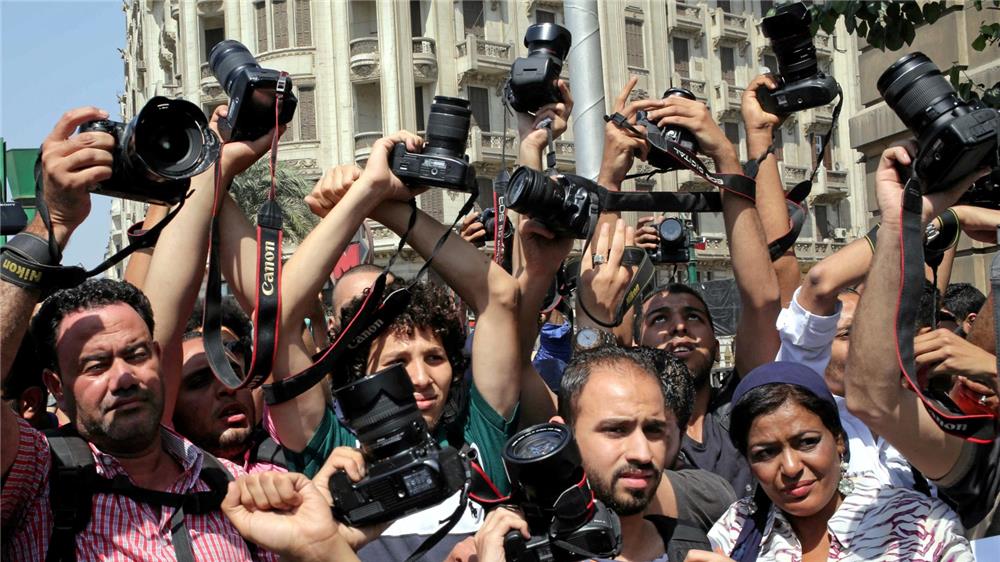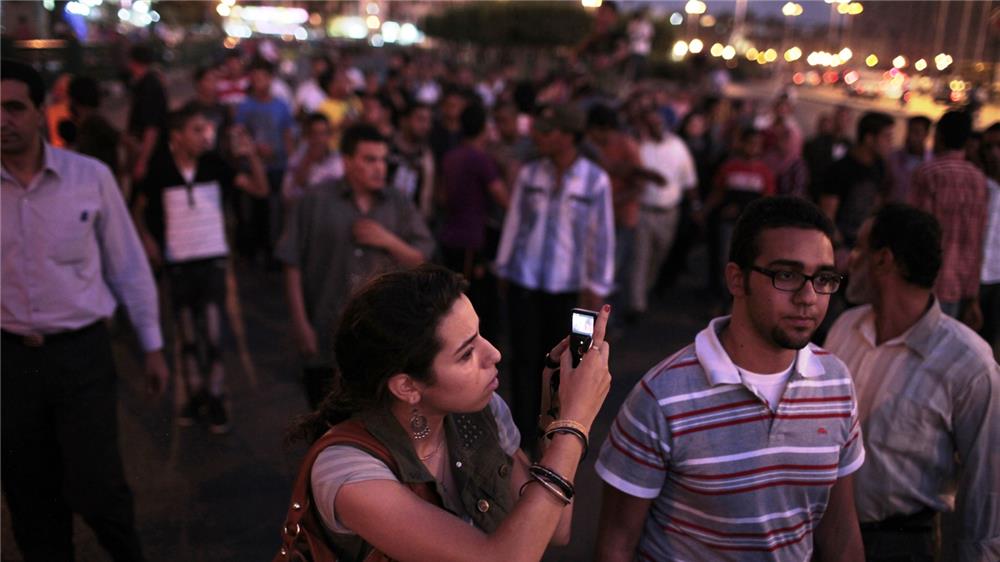على مدار أكثر من ثمانين عاما، عمل العديد من النساء المصريات في مجال الصحافة على اختلاف صورها. في البداية كان العمل في الوسيلة الوحيدة المعروفة والمتاحة -أي الصحافة المكتوبة- أشبه بحرب يجب أن تخوضها المرأة كي ترسم لنفسها مكانا على الخارطة الإعلامية المحدودة آنذاك، بل كان العمل في أي مجال يستدعي المحاربة.
أما الاشتغال بالصحافة، فقد كان مرتبطا بصورة عامة لدى الرجال والنساء بالثقافة.. الصحفي بالضرورة مثقف وثقافته شاملة ومنوعة، يتمتع بقاعدة معرفية ورؤية تحليلية، بينما يعتمد العمل الصحفي في الحاضر بصورة كبيرة على احتراف التقنية (من كيفية تحرير الخبر وصياغته، وتتبع المصادر، والتمكن من أدوات صنع المادة الخبرية، والقدرة على التعامل مع التكنولوجيا اللازمة لذلك، سواء في وسيلة مسموعة أو مرئية أو حتى مكتوبة).. وبتنوع وسائل الإعلام تتنوع التقنيات.
وبدا أنه كلما تطورت الوسيلة الإعلامية وازدادت حداثة، تضاءلت الحاجة إلى الثقافة وسعة الاطلاع والمعرفة.. وتلك مفارقة تبتعد قليلا عن المنطق، فالمعلومات أصبحت متاحة بصورة قد يكون مبالغا فيها. أما نسبة الإقبال على تلك المعلومة والرغبة في المعرفة فتتضاءل إلى حد التلاشي في بعض الأحيان.
وعمل المرأة المصرية بالصحافة لم يكن بعيدا عن هذا التحول، إلا أن بدايات عملها ارتبطت بأمرين: أولهما النضال من أجل اشتغال امرأة في هذا المجال من الأساس، والتوعية بأهمية عمل المرأة وحقوقها، فكانت مهمة تنويرية في المقام الأول. والثاني هو النضال ضد الاستعمار البريطاني لمصر في تلك الحقبة.

في مجال الصحافة المكتوبة كانت عميدة الصحفيات المصريات والمحامية والكاتبة الصحفية منيرة ثابت أول حاصلة على شهادة الليسانس من مدرسة الحقوق الفرنسية، وأول صحفية مصرية نقابية، وأول رئيسة تحرير لجريدة سياسية.. وقد واجهت الكثير من التضييق كمحامية، مما دفعها للكتابة والاتجاه إلى الصحافة عام 1926.
أصدرت منيرة جريدتين: يومية فرنسية، وأسبوعية عربية باسم "الأمل"، وكانت موضوعاتهما في السياقين "تحرير الوطن وتحرير المرأة".
في تلك الفترة كانت الحركات النسائية في بداية تشكلها متأثرة بالحراك النسائي الأوروبي، والبريطاني على وجه الخصوص. ومن أبرز الأمثلة كذلك، الكاتبة والصحفية درية شفيق إحدى رائدات حركة تحرير المرأة في مصر.
كانت الصحافة لهذا النموذج من النساء سلاحا ووسيلة لأهداف أكبر، فعندما أسست درية مجلة "بنت النيل" (أول مجلة نسائية ناطقة بالعربية)، حوّلتها بعد ذلك إلى اتحاد ثم إلى حزب سياسي.
لحقت الصحافة المسموعة أو الإعلام الإذاعي بالصحافة المكتوبة، فكان الإعلان الرسمي لافتتاح الإذاعة المصرية ككيان حكومي لا كإذاعة أهلية في العام 1934.
وأحد أهم الأصوات النسائية وأولها كان صوت صفية المهندس الملقبة "بأم الإذاعيين"، التي تعتبر من مؤسسي الإذاعة المصرية.
اختلفت طبيعة العمل الصحفي الإذاعي عن المكتوب في تلك الحقبة، فكان مضمون البرامج التي تقدمها النساء خاصة أكثر ميلا إلى مناقشة موضوعات اجتماعية تخص الأسرة وشؤون المرأة المصرية والعربية.
قد يرجع هذا إلى كون الوسيلة في حد ذاتها لم تكن على نفس القدر من القرب من العمل السياسي والنضال، وبالتالي تحمل نبرة أقل حدة. وربما أيضا لأنها -وحتى اليوم- كيان تملكه الدولة وبالضرورة يعكس صورتها ومنظورها للأمور، وليست ككثير من الصحف أهليةً أو خاصة. هذا إلى جانب طبيعة الوسيلة الإعلامية التي تختلف عن المقروءة من حيث الروح التي لا بد أن تتسم بنبرة أكثر ودا، وبأسلوب أقل تعقيدا، وبمعلومة مبسطة سريعة يسهل على المستمع التقاطها في الثانية التي تصدر فيها بلا فرصة للمراجعة. وكانت مقاييس الاختيار للمذيعة تضم جودة الصوت والقبول الصوتي وسعة الاطلاع.
ومن أهم أعلام بدايات النصف الثاني من القرن العشرين من النساء في الإذاعة المصرية، آمال فهمي التي اشتهرت بالتواصل المباشر مع الناس في أحد أشهر البرامج الإذاعية الاجتماعية المصرية على الناصية.
كما كانت هاجر سعد الدين أول امرأة تقدم برنامجا إذاعيا في الفقه الإسلامي بإذاعة القرآن الكريم. وأشهر مقدمة برامج أطفال -بل تعدُّ الوحيدة اليوم- هي أبلة فضيلة.
وبعد انطلاق البث التلفزيوني في مصر، ظهر مع هذه الوسيلة الجديدة نجمات جدد لا يختلفن في الروح أو الأداء أو حتى في طبيعة المضمون المقدم للمتلقي عن مقدمات البرامج الإذاعية. ويضاف إلى معايير اختيار الإعلامية التي تظهر على الشاشة معيار المظهر، الذي لم تكن فيه أية مغالاة، بل كان التركيز الأكبر على المضمون في حدود اللائق والمتاح بصريا في ذلك الوقت. لكن وكما هو معروف، فإن للشاشة بريقا جعل من يعملون خلفها نجوما بجهد أقل.
وظلت هذه هي الحال حتى ثمانينيات القرن العشرين على شاشة التلفزيون المصري. ومن بين من تألقن على شاشته ليلى رستم وسلوى حجازي وهمت مصطفى وأماني ناشد.
طبيعة البرامج التي قدمتها الإعلاميات المصريات على مدار عشرين عاما على الشاشة المصرية كانت اجتماعية أو فنية، ولم يكن لهن نصيب من تقديم البرامج السياسية أو الاقتصادية، باستثناء نشرة الأخبار التي كانت زينب سويدان من أشهر مقدماتها.
لم يطرأ على الصحافة المكتوبة -خاصة ما تكتبه الصحفيات- الكثير من التغيرات، لكن بسبب الظروف التاريخية السياسية وكذلك الثورة الفكرية التي ألقى الغرب طرفا من ردائها على بقية العالم، تميزت الكتابات الصحفية النسائية بالجرأة، في ظل أجواء عامة من الحرية الفكرية لا تخص النساء تحديدا، وهذا حتى فترة السبعينيات.
غير أن هذه المساحة من الحرية تراجعت بسبب تغير تلك الظروف وظهور تيارات دينية مقيدة للمرأة على وجه الخصوص، بالإضافة إلى التضييق السياسي على الصحفيين والصحفيات أصحاب الآراء والكتابات المنتقدة للنظام السياسي. صافيناز كاظم مثال لصحفيات اضطررن لمغادرة مصر لهذا السبب، وعملت في تدريس الدراما بجامعة المستنصرية في العراق منتصف السبعينيات.
وفي تسعينيات القرن الماضي، ومع بداية ظهور القنوات التلفزيونية الفضائية الخاصة، تراجعت شعبية كل ما سبقها من وسائل إعلامية أخرى، وتغيرت على إثرها الكثير من المقاييس، ومنها طريقة اختيار الإعلاميات. فبسبب كون تلك القنوات ربحية في المقام الأول، ينبغي أن تكون مقدمة البرامج وجها جاذبا وشخصية مثيرة للاهتمام لرفع نسبة المشاهدة التي بالتالي تؤدي إلى إقبال المعلنين.
ومع تضاعف عدد القنوات أصبح من الصعب إيجاد جميع المواصفات الجاذبة للمشاهد في الشخصية الإعلامية مع ضمان الاحترافية في التعاطي الإعلامي، الأمر الذي أدى إلى انحدار في مستوى تناول الموضوعات ثم في مستوى الموضوعات ذاتها، وإن كانت هناك نماذج نسائية أثبتت جدارتها مهنيا وبمقاييس متعددة في العصر الحالي، ومنها دينا عبد الرحمن ومنى الشاذلي على سبيل المثال. أما البرامج التي تقدمها إعلاميات مصريات فهي تقريبا في كل المجالات.
ونظرا للظروف والمتغيرات السياسية التي مرت بها مصر منذ العام 2011، فقد كانت الغلبة في الساحة الإعلامية -تحديدا الفضائيات- للبرامج الحوارية اليومية وتغطيتها للأحداث الجارية، مما جعل المضمون المعروض شبه متماثل. وصارت المنافسة شرسة بين تلك القنوات في جذب المشاهد، وبالتالي أصبح المعيار في اختيار الإعلامية أو وجه القناة ليس الوجه والمظهر، وإنما القدرة على تقديم نفس المعلومة ومناقشة الحدث ذاته بأسلوب خارج عن المألوف. وهنا يعتمد الأمر إما على تفرد شخصية المقدمة أو اعتمادها أسلوبا مثيرا للجدل -وهو المفضل لدى المعلنين- أو قوة فريق إعداد برنامجها الذي يؤمّن لها "الحصري" من التصريحات أو الضيوف.
وهكذا، لم يعد شرطا أن تكون مقدمة البرنامج متخصصة في مجال الإعلام المرئي، فإن توافرت فيها أي من المواصفات الجاذبة لنسبة مشاهدة أعلى فهي الوجه الذي يستحق الظهور.
أما البرامج الترفيهية فمقدماتها ربما لا يختلفن شكلا أو مضمونا مع نظيراتهن في دول عربية أخرى. بيد أن الملحوظ في الآونة الأخيرة -وقد صار أشبه بالظاهرة في الأشهر الفائتة- أن الإعلاميات الجدد في كثير من الحالات هن فنانات ذوات شهرة واسعة، إما في مجال الغناء أو التمثيل. وهذا بالطبع يخص البرامج الترفيهية البحتة ذات المضمون الحواري أو الغنائي، مما يوضح مدى الاهتمام بنسبة المشاهدة. وامتدت تلك الفكرة إلى الإذاعة أيضا، وصار عدد كبير من مقدمات البرامج من الفنانات.
وبعد أن كانت المتقدمة لوظيفة مذيعة أو مقدمة برامج تمر باختبارات يرأسها متخصصون في المجال -وهذا لا يزال يطبَّق في الإذاعة المصرية التابعة للدولة- صارت الإذاعات الخاصة لا تعتمد في اختيارها على المعايير التقليدية، وإنما يقع الاختيار على المذيعة التي تستطيع تقديم فكرة "مجنونة" مثلا. بل إن إحدى تلك الإذاعات باتت تعتمد نظام التصويت للمتسابقات من قبل المستمعين شرطا للحصول على وظيفة، وهي فكرة لا يراها البعض ذكية فقط في جلب الأرباح، وإنما أيضا منطقية من باب أحقية المستمع في الاختيار.
ورقعة الحرية تلك اتسعت بصورة أكبر بسبب ظهور مواقع التواصل الاجتماعي التي صارت تُحتسب من وسائل الإعلام، بل قد تكون الأقوى تأثيرا. فأصبح هناك ما يعرف بصحافة المواطن التي تمكِّن أي شخص -رجلا كان أو امرأة- أن يعمل بالصحافة ولو من باب الهواية. وفي هذا الإطار ليس هناك معيار ضابط أو مقاييس اختيار. ولكن ربما أعطى هذا المرأة مساحة أكبر للتعبير.








































